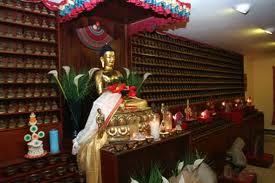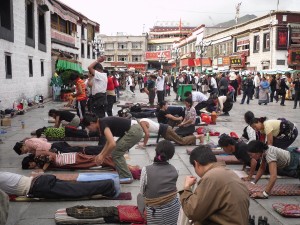The following is an excerpt from a teaching by Jetsunma Ahkon Lhamo called “The Guru is Your Diamond”
Guru Yoga can always be depended on to reestablish and continue the blessing. I promise you, if we call out to the guru with full heart, with determination and with fervent regard and recognition, the guru will respond, whether it’s in the way that you would like which is ‘Hi! I’m here for lunch,’ or whatever. It may not be that way. It may be something quite different; and sometimes it’s not something that feels good right away. One of my favorite students works herself to death and forgets to practice sometimes, and then periodically does things like break her back or, you know, injure herself in some way. And then she practices and amazing things happen. I wish she wouldn’t do it that way, but she does. You know who I’m talking about, out in Sedona. I have other students that kind of orchestrate separation and return in order for that feeling of return. But I wish they wouldn’t do that, because that feeling of separation often comes with some cause and effect relationship. And again if it were my diamond, I’d be shining it up all the time. I’d be collecting that interest all the time.
We use Guru Yoga that way to create the causes for continuation on the Path. The teacher should never be frightening. The teacher is your friend, your friend who will take your hand and walk you, lifetime after lifetime, even when you stumble and you fall. Something will arise through the devotion that you practice in this lifetime to protect you even in your next life. Eventually we come to the place where we see everything as the blessing of the guru. Everything. Sometimes we feel some confusion, and maybe even confusion for a long time, but you know that that guru would not let you down. You know that. And so you count on that, even the confusion, to be a blessing. Eventually because of that devotion, the confusion will clear and the guru will appear again like an underground spring coming once again to the surface.
Guru Yoga is the most potent of all practices and it’s the most simple. One can practice Guru Yoga simply by visualizing the guru above the crown of one’s head and making offerings in a visualization way, and then receiving the blessing, real quick. The white blessing from the guru’s body to your body, and it does come in the head, white to white; the red blessing from the guru’s speech, from the throat to your throat; the blue blessing from the guru’s mind, which is the heart, from his heart to your heart (or her heart). And you can receive that blessing constantly. It’s free. It’s yours. You can receive it periodically. You can receive it every morning, every night—whatever you want, as much as you want. That’s the beauty of Guru Yoga. You should think that the guru is like your constant companion. Not in a creepy way. I don’t want you guys looking in my window, But in a wholesome way, where we understand that this nature is freely given, like method that one can use. It is indistinguishable from the ground which is full Enlightenment, the method which is Dharma, and the result which is the completion or accomplishment of the precious awakened state.
So we understand the guru is the ground, the guru is the method, the guru is the result. We begin to mix, through the devotion, through calling out our own nature, our own mind, our own qualities, willingly with that of the guru; and over time, that blessing mixes like milk with water and we understand that, indeed, Lord Buddha resides in us all. We understand that indeed each one of us is some uncontrived beginningless and endless and yet fundamentally complete luminous nature, some state of awakened and yet uncontrived view. That we are that in our nature. And our job in this lifetime is to use the blessings of our gurus, to use their accomplishment, their qualities, their methods; to listen carefully and accordingly accomplish awakening to that, awakening to that nature. It’s the swift way. It’s the rocket ship. It’s powered because it’s like lighting something at both ends. You’re not thinking, ‘Oh I have to go there.’ We are thinking, ‘This is like a mirror and a mirror,’ inseparable in their nature.
Copyright © Jetsunma Ahkon Lhamo. All rights reserved




